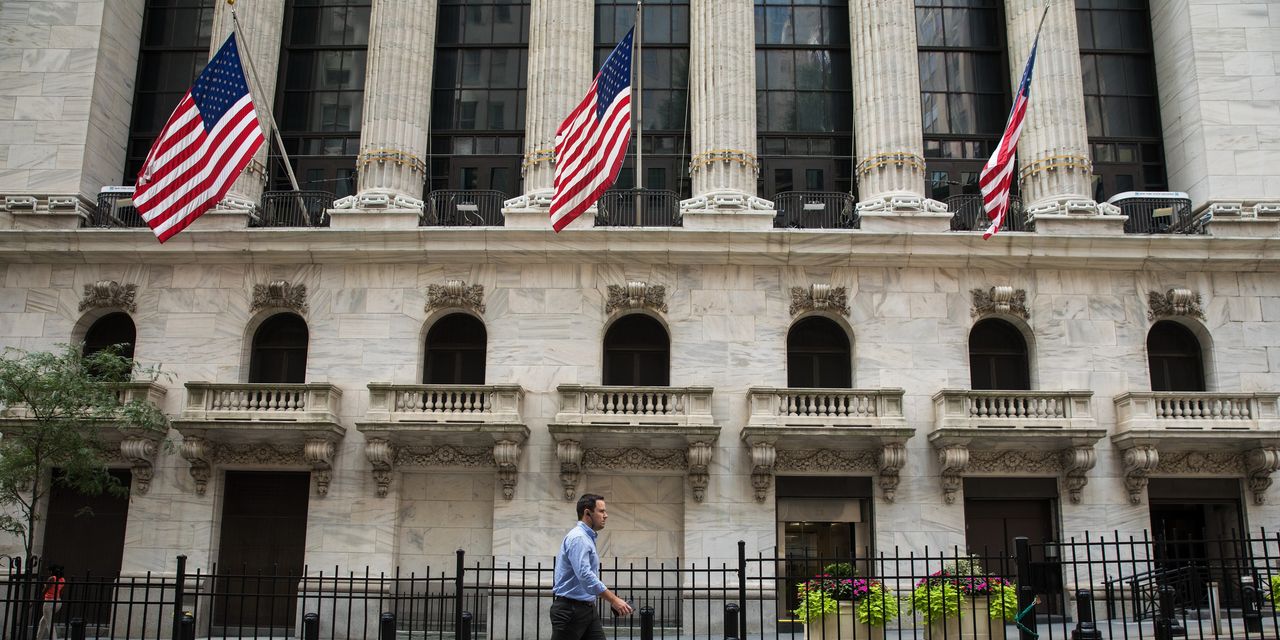The stock market on Monday suffered its biggest one-day fall since October as investors appeared to take a cue from the bond market and started worrying about growth.
The question for traders is whether it is spooky enough to trigger what many view as a long overdue selloff, or merely offers yet another dip-buying opportunity for the bulls.
The rates market has been “signaling growth concerns for the last several months,” said Marvin Loh, senior global markets strategist at State Street, in a phone interview.
The culprit getting most of the blame Monday was the delta variant of the coronavirus that causes COVID-19, and which is responsible for growing infections around the world, including the U.S. and other countries that have rolled out vaccines. Fears of renewed travel restrictions and the further spread of the highly transmissible variant, particularly among the unvaccinated, put pressure on travel-related stocks and other industries and sectors that had previously been beneficiaries of bets on cyclical companies expected to benefit the most from the economic reopening.
In the end, the Dow Jones Industrial Average
DJIA,
fell 725.81 points, or 2.1%, to close at 33,962.04, its biggest one-day percentage and point drop since Oct. 28. The S&P 500
SPX,
gave up 68.67 points, or 1.6%, to end at 4,258.49, while the Nasdaq Composite
COMP,
shed 152.25 points, or 1.1%, finishing at 14,274.98 — the worst day for both indexes since May 12. Meanwhile, the small-capitalization Russell 2000 index
RUT,
fell 1.5% to 2,130.68, avoiding a close in correction territory at or below 2,124.15, representing a drop of at least 10% from a recent peak.
Spreading the blame
But the delta variant wasn’t solely to blame. Loh noted that prospects for additional fiscal stimulus from Washington have been stalled for some time. An earlier boost for the reopening trade had come after runoff Senate elections in Georgia in January that handed razor-thin control of the upper chamber to Democrats and raised prospects for passage of aggressive fiscal measures pushed by President Joe Biden.
Investors were also citing U.S.-China tensions, after the Biden administration blamed Beijing for a hack of Microsoft Exchange email server software that compromised tens of thousands of computers around the world earlier this year. The European Union and Britain also pointed the finger at China.
But after an initial victory on a major spending plan, efforts toward a large infrastructure spending bill and plans for additional measures have bogged down, leaving only monetary policy in focus.
And while the Federal Reserve isn’t rushing to pull back on bond buying or raise interest rates, a pullback in monetary stimulus is in sight. And other major central banks, including the European Central Bank and Bank of Canada, are also looking toward reducing stimulus efforts, Loh said.
The delta variant, meanwhile, “makes things that much more uncertain in terms of how thing are going to regress,” Loh said, noting that “peak growth is something that is being talked about a lot more.”
Meanwhile, yields on long-dated U.S. Treasurys and other developed market bonds have tumbled. Indeed, the drop in the 10-year yield
TMUBMUSD10Y,
which had risen to nearly 1.8% in March as growth expectations surged and inflation fears mounted, subsequently slumped. On Monday, it traded below 1.20% for the first time since mid-February. Yields and debt prices move in opposite directions.
Stagflation redux?
For some investors, declining yields reflect fading inflation fears, with investors demanding less of a premium to protect future coupon payments from being eroded by inflation. But others argued that the fall in yields and Monday’s stock-market fall point to rising fears of stagflation, a term often associated with the 1970s mix of rising inflation and unemployment.
See: Why a bond rally could drive the 10-year Treasury yield lower still, even as inflation expectations become unmoored
“The global economy is barely surviving on life support, and another wave of infections may spur lockdowns that could signal the death knell for the tenuous recovery,” said Peter Essele, head of investment management for Commonwealth Financial Network, in emailed remarks.
“Fear of stagflation will be a major concern for investors if a resurgence in COVID infections causes economies to slow while consumer prices continue an upward trajectory,” he said. “The strong performance of inflation-linked bonds as of late may be an indication that those fears are setting in, with the bus already having left the station.”
Keeping it in perspective
But others saw the Monday selloff as long overdue given a run that saw major indexes continue to set all-time highs as recently as last week.
Indeed, the fact that Monday’s declines were the biggest in months might be testimony more to the lack of market volatility that has accompanied the stock-market rally. The S&P 500 hasn’t pulled back at least 5% from a recent high since late October, according to Dow Jones Market Data.
That is one of the longest stretches without such a pullback in the past decade, wrote analysts at Truist Advisory Services, in a note. “Historically, we tend to see two or three 5%-plus pullbacks a year, all of which come with negative headlines,” they noted.
Indeed, a pickup in volatility accompanied the rising worries about COVID and new variants has triggered a pickup in volatility, with the Cboe Volatility Index
VIX,
jumping in recent sessions to trade above 22 in late Monday action, after trading near 14 around two weeks ago, below its long-term average near 20.
That is helped feed weakness in equities, said Mike Lewis, head of U.S. equities cash trading at Barclays, in emailed comments.
The volatility jump causes “systematic” traders, particularly trend-following commodity trading advisers, “to take profits on recent equity gains, creating a lot of supply into an equity market with low summer volumes, and not a great liquidity backdrop.”
[ad_2]
Source

